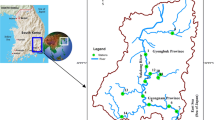Abstract
Riverine sediments and suspended matters have been subjected to several bench scale tests for the evaluation of adsorption potential of heavy metals. For this purpose water, sediment and suspended particulate matters of Tadjan River (southern part of the Caspian Sea) were collected. In the vicinity of the river many polluting sources were recognized; for instance, pulp and paper mill, dairy factory and municipal sewage that can introduce various amounts of heavy metals into the river water. Bottom sediments and suspended particulate matters have been individually subjected to adsorption tests. The results of analysis showed that riverine bottom sediments have greater potential for adsorbing heavy metals than suspended matters. However the trend of adsorption in both sediments and suspended matters are similar. Maximum adsorption capacity of heavy metals (in terms of mg of metal per kg of sediments and suspended matters) by sediments and suspended matters are as: Sediments: Cu (2200)> Mn (2000)> Ni (1400)> Zn (320) Suspended matters: Cu (2100)> Ni (1500)> Mn (1200)> Zn (310) Further, results revealed that increasing concentration of metals would cause desorbing Cadmium from both sediments and suspended matters.
Similar content being viewed by others
References
Benefield, L. D., J. F. Judkins, and B. L. Weand, Process chemistry for water and wastewater treatment. Prentice-Hall, 1982
Chapman, D., Water quality assessment. Chapman and Hall, London, 1992
Dojlido, J. R. and G. A. Best, Chemistry of water and water pollution. Ellis Horwood, 1993
Forstner, U. and G. T. W. Wittmann, Metal pollution in the aquatic environment. Berlin: Springer, 1981
Hart, B. T., Uptake of trace metals by sediments and suspended particulates: a review. Hydrobiologia, 91: 299–313, 1982
Karbassi, A. R., Geochemical and Magnetic Studies of Marine, Estuarine and Riverine Sediments. Mangalore University, India, 1989
Lin, J. G., and S. Y. Chen, The relationship between adsorption of heavy metal and organic matter in river sediments. Environment International, 24: 345–352, 1998
Rose, S., The heavy metal adsorption characteristics of Hawthorne formation sediments. Chemical Geology, 74: 365–370, 1989
Sholkovitz, E. R., and D. Copland, The coagulation, solubility and adsorption properties of Fe, Mn, Cu, Ni, Cd, Co and humic acids in a river water. Geochim Cosmochim Acta, 45: 181–189, 1981
U.S. EPA, Test methods for evaluating solid wastes. SW-846, 1990
U.S. EPA., Methods for the determination of metals in environmental samples. EPA-600/4-91/010, 1991
Zhou, X. D., and S. C., Kot, Heavy metals ion adsorption on sediments of the Weiho and Hanjiang rivers. China, J., Environmental Hydrology, 3: 125–132, 1995
Author information
Authors and Affiliations
Corresponding author
Rights and permissions
About this article
Cite this article
Saeedi, M., Daneshvar, S. & Karbassi, A.R. Role of riverine sediment and particulate matter in adsorption of heavy metals. Int. J. Environ. Sci. Technol. 1, 135–140 (2004). https://doi.org/10.1007/BF03325826
Published:
Issue Date:
DOI: https://doi.org/10.1007/BF03325826




